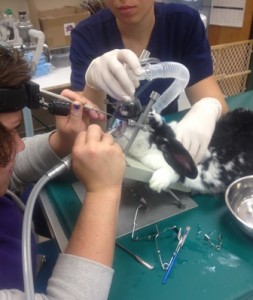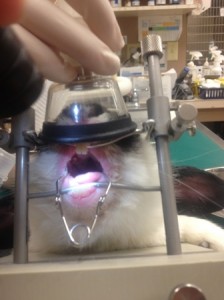Rabbits make wonderful pets. Once you and your family learn about the basic care and dietary requirements, you can enjoy many years with your furry friend. There are several breeds to choose from, and they all have the same general characteristics.
Diet and digestive system:
First of all, a rabbit’s digestive system is similar to a horse. Rabbits have very little stomach and small intestine. They do, however, have one huge appendix. We call that a “cecum.”
Because of their anatomy, rabbits require hay daily as a natural fiber source to live well and stay healthy. A rabbit’s diet should consist of 80% grass hay. Oxbow is a good company who makes little bales of hay for rabbits. Pellets should be a really small portion of their diet, and if they eat all their hay, give them more hay. A diet of pellets and very little hay will take its toll on your rabbit’s digestive system and teeth.
You can also feed a minimum of one cup vegetables for each 4 lbs. of body weight. You can select three different types of dark green or yellow vegetables daily such as alfalfa sprouts, basil, beet greens, broccoli leaves, Brussels sprouts, carrot and carrot tops, cilantro, collard greens, endive, green peppers, parsley, romaine lettuce, kale, outer cabbage leaves, wheat grass, pea pods but not peas, squash, radicchio or dandelion leaves.

Rabbits eating greens
You may add a small amount of fruit (up to 3 types) totaling 1-2 level Tbsp per 5 lbs. body weight. Stick to high fiber fruits like apple, peach, plum, pear, melon, raspberry, papaya, blueberry, blackberry, strawberry and pineapple. Avoid sugary fruits like bananas and grapes, and feed no fruits at all if dieting.
Symptoms that your rabbit is not feeling well:
Also, like a horse, rabbits cannot physically vomit. Because they cannot vomit, that is one less warning sign that your bunny may be ill. For a rabbit, their stomach will explode before they vomit. You will have to look for other symptoms.
It might not be obvious, but you may notice your rabbit is simply more quiet than usual. Rabbits are quiet anyway, so it’s important to know what level of activity is normal for your pet. Maybe your rabbit is simply moving around less. An obvious symptom is that your bunny is simply not eating, and even more important is that your rabbit is no longer defecating. This indicates your rabbit may be in serious trouble.
If a rabbit does not eat for whatever reason (gas pain, infectious disease, inflammatory disease), its appendix (cecum) shuts down and starts filing up with gas. That becomes painful and a viscous cycle has begun.
One of the things we try to teach owners is how to force feed their rabbit. If someone calls on a holiday, an emergency treatment to help a rabbit feel better quickly and cheaply is to force feed it, especially if we cannot get to the pet or if the owner cannot get their rabbit into an emergency clinic immediately for any reason.

Force feeding bunny with Oxbow Critical Care
We recommend force feeding with Oxbow Critical Care. This is basically a fiber product that you mix with water. We teach people how to administer it, and we discuss it in the exam room during a wellness visit. Sometimes an owner can save their rabbit’s life if they can’t get it into the hospital quickly enough.
In the old days, veterinarians would X-ray rabbits, see a hairball in their stomach and think surgery was required to remove it. We have since learned that 99.9% of the time, rabbits who are constantly grooming themselves will naturally have a hairball in their stomach. Usually the hairball is not the problem, and if the rabbit has not eaten for three or more days, sometimes surgery can hasten their demise. The solution becomes rehydrating them with food and water to open up their intestine quickly and making sure they are eating the proper diet going forward.
Why dental exams are important:
Rabbits are born with one set of teeth. Their teeth are designed for eating hay in that they are perfectly even and grind the top and the bottom teeth together. Rabbits have front teeth and back molars, but no teeth in the middle. The back molars are what the owners can’t see. Veterinarians can only see them during an exam by using a special instrument.

Rabbit Dental

Rabbit dental with malocclusion and in need of Orthodontist
When the back molars develop sharp points that begin to lacerate the rabbit’s tongue, the rabbit experiences pain and cannot eat properly. Sometimes I find a rabbit has been literally starving for weeks or months because it cannot eat properly, and the owner is not even aware.
It’s therefore important to note a rabbit’s weight during every exam. If the rabbit has lost 5-8 oz. in the past six months, usually 99% of the time it’s a medical issue. Five ounces is nothing for us, but for a rabbit, this is a serious danger signal that something is medically wrong.
Checking your rabbit’s teeth and weight once or twice a year and making sure they are eating the proper diet is lifesaving. They do need to be seen by a veterinarian, and this is where the education process begins for the owner.
Please feel free to call our office if you have any questions, would like a tour of our facility or want to schedule an appointment.
Joe Martins, DVM, Belle Mead Animal Hopsital

Joe Martins, DVM, Belle Mead Animal Hospital


